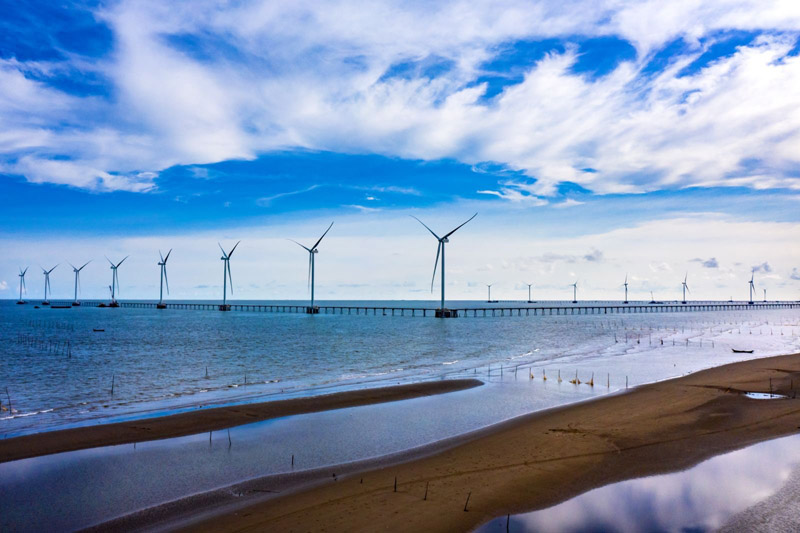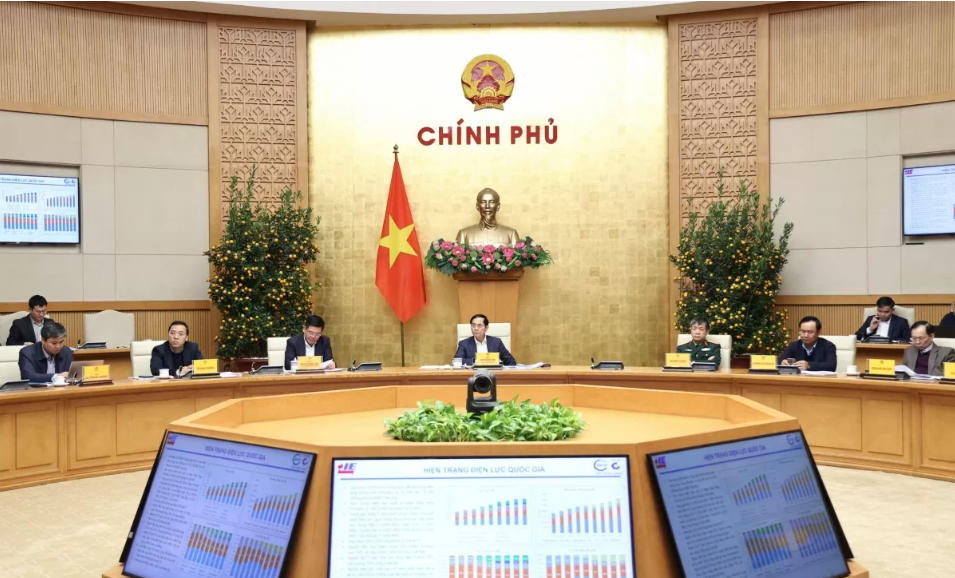Vietnam scales back plan to boost offshore wind
The World Bank has estimated Vietnam’s offshore wind potential at around 600 GW, with projections that the sector could provide 12% of the country’s total electricity generation by 2035.
The Ministry of Industry and Trade (MoIT) has proposed delaying the development of offshore wind power until after 2030, revising its original goal of approximately 6,000 MW within the next five years.
| The Dong Hai 1 wind power project. Photo: Trung Nam Group |
By 2050, offshore wind capacity could reach 70,000 MW to 91,500 MW, making a significant contribution to the country's renewable energy.
However, the revised plan sets a target of only 17,000 MW of offshore wind power development by 2035, as this source of renewable energy will remain a costly option before 2030, Minister of Industry and Trade Nguyen Hong Dien said at a meeting of the Appraisal Council for the Adjustment of Plan VIII on February 19.
Meanwhile, the total capacity of onshore and offshore wind power will be increased to 27,791-34,667 MW by 2030, about 15% higher than the current plan.
The World Bank has estimated Vietnam’s offshore wind potential at around 600 GW, with projections that the sector could provide 12% of the country’s total electricity generation by 2035.
Several foreign investors, including Danish group CIP and Germany’s PNE, have expressed interest in offshore wind power projects in Vietnam. More than two years ago, 36 domestic investors applied for offshore wind surveys. However, the then Ministry of Natural Resources and Environment suspended approvals due to legal issues.
Vietnam faces significant challenges in offshore wind power development, including regulatory inconsistencies concerning maritime activities, high capital investment requirements, and national defense and security considerations.
According to Bruno Jaspaert, Chairman of the European Chamber of Commerce in Vietnam (EuroCham), an offshore wind project takes at least three years to build. This means that to meet the 6,000 MW target by 2030, projects would need to break ground by 2027, with all necessary permits secured by early 2024, said
| Overview of the Government meeting. Source: VGP |
This year, the Government is targeting GDP growth of at least 8%, with double-digit growth expected between 2026 and 2030. To ensure sufficient electricity supply, the MoIT projects that Vietnam’s total installed capacity by 2030 will need to range between 183,291 MW and 236,363 MW, representing an 18-54% increase from the current plan.
Regarding coal-fired power, total capacity by 2030 is set to increase by 928 MW due to adjustments in actual power plant capacity. Domestic gas-fired power capacity will remain unchanged at around 10,861 MW.
The revised plan also proposes to postpone several delayed liquefied natural gas (LNG) power projects until after 2030, with total LNG power capacity by 2030 projected at 8,824 MW, a reduction of 13,576 MW from the original target of the Power Development Plan VIII.
Meanwhile, hydropower, renewable energy, and battery storage capacity will be expanded. The government plans to maximize hydropower potential, with medium and large hydropower projects reaching a total capacity of around 21,100 MW, an increase of 1,600 MW. Small-scale hydropower capacity will reach 13,500 MW, up by 5,400 MW from the current plan.
Total solar power capacity, including utility-scale and rooftop installations, will range between 46,459 MW and 73,416 MW, marking an increase of 25,867 MW to 52,825 MW. This is due to solar power’s rapid deployment capability, which can help meet the growth in electricity demand in 2026-2027.
Regarding the Ninh Thuan nuclear power project, the minister stated that the total capacity of the two planned plants is expected to be between 6,000 MW and 6,400 MW, with completion scheduled for 2030 and commissioning between 2030 and 2035. By 2050, Vietnam’s nuclear power system will be expanded with an additional 4,500-5,000 MW in the north and around 3,000 MW in the central region, mainly using small modular reactors (SMRs).
"Potential sites for nuclear power development will be studied in subsequent planning phases beyond the Power Development Plan VIII," Dien noted.
For the 2026-2030 period, total investment in Vietnam’s power sector is estimated at $136-172 billion, including $118-148 billion for power generation and $18-24 billion for transmission networks.
To meet this large capital requirement, the MoIT has proposed diversifying financial sources and fundraising mechanisms, including bank loans, foreign aid, and stock market financing. The government also aims to attract both domestic and international investors and encourage greater private sector participation in the power industry.












